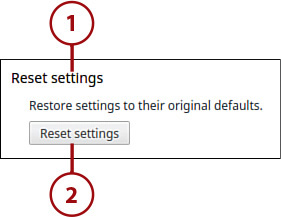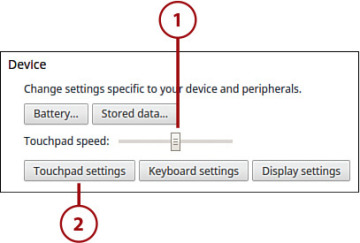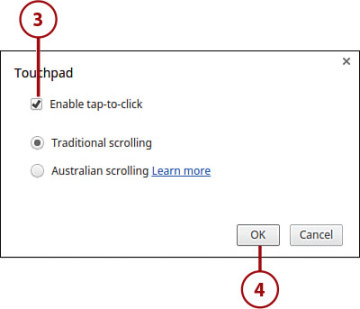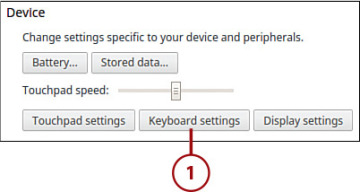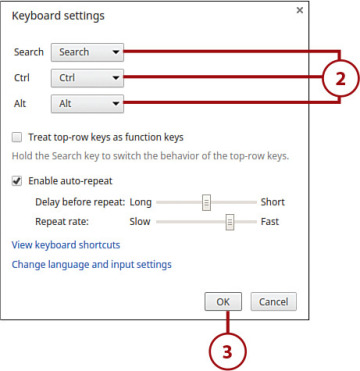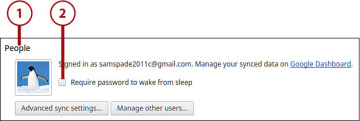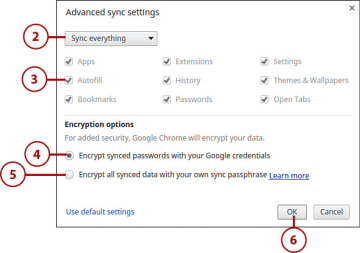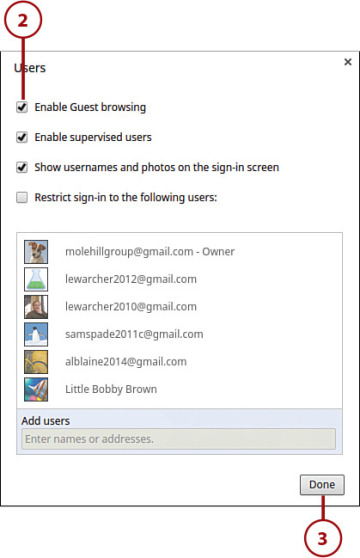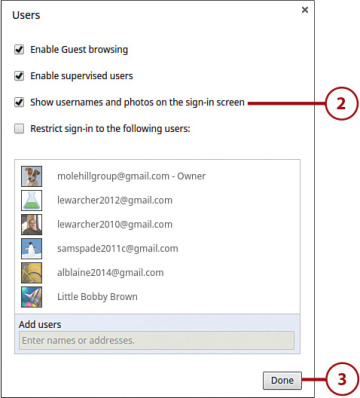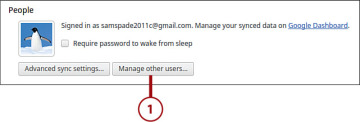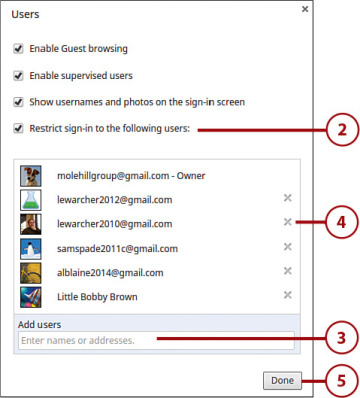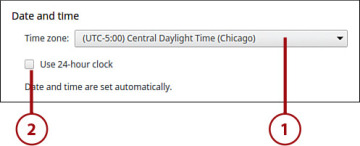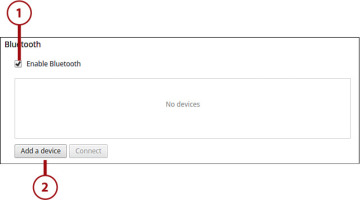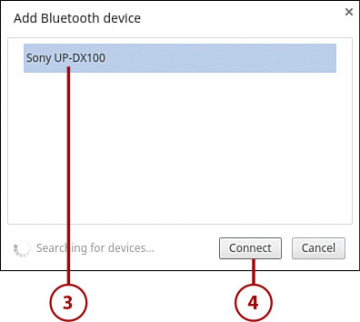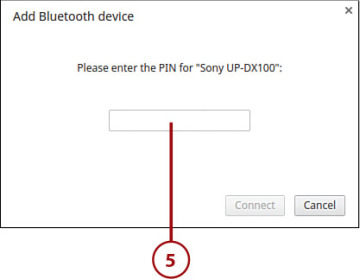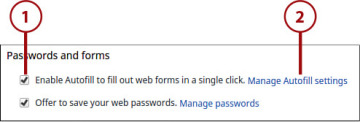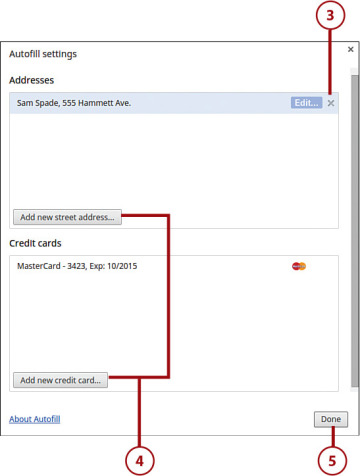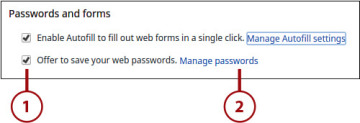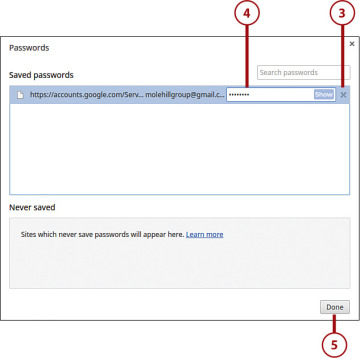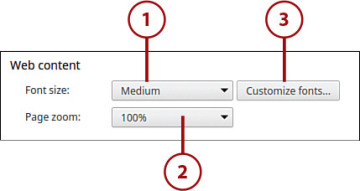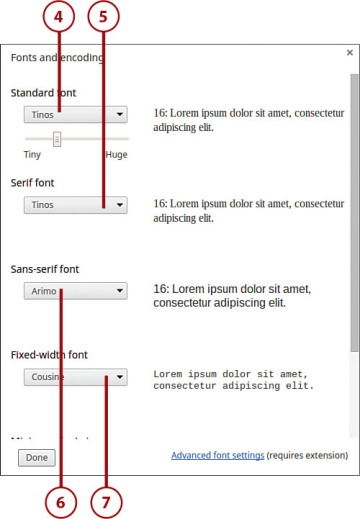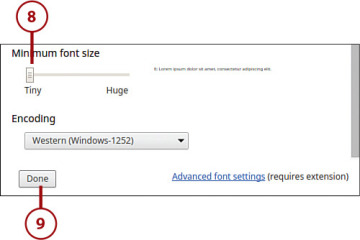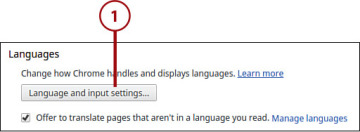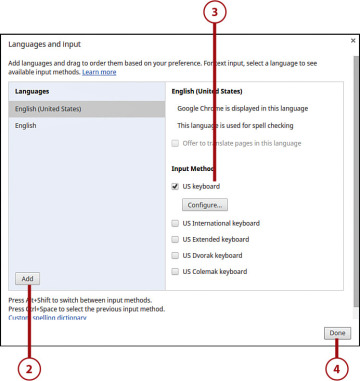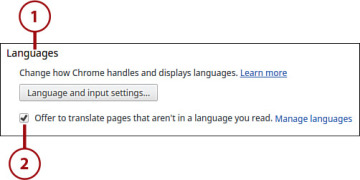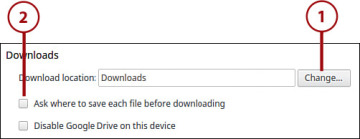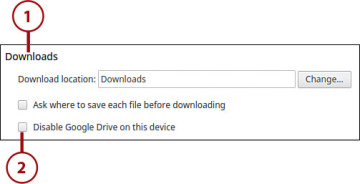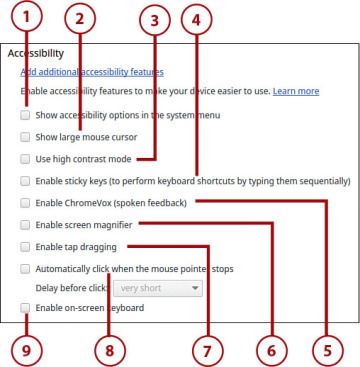- Personalizing the Desktop
- Configuring the Chrome Browser
- Configuring Other Settings
Configuring Other Settings
There’s more you can customize about Google Chrome, all accessible from the Settings page—which you get to by clicking anywhere in the status area and then clicking Settings. (Some settings may only be visible when you click Show Advanced Settings at the bottom of the page.)
Configure the Touchpad
Don’t like the way your Chromebook’s touchpad works or feels? Then change it.
- To change the sensitivity of the touchpad, go to the Device section and adjust the Touchpad Speed slider.
To disable tap-to-click functionality (which then requires you to tap only at the bottom area of the touchpad), click the Touchpad Settings button to display the Touchpad Settings panel.
- Uncheck the Enable Tap-to-Click option.
Click OK.
Change Search, Ctrl, and Alt Key Behavior
As previously noted, the Chromebook keyboard does not include some familiar keys, such as the Caps Lock key. You can, however, reconfigure how the Search, Ctrl, and Alt keys work in Chrome—and thus turn these keys into other keys that you might be missing.
Specifically, you can modify these keys as follows:
- Search—Change to Ctrl, Alt, Caps Lock, or disable.
- Ctrl—Change to Search, Alt, or disable.
- Alt—Change to Search, Ctrl, or disable.
Go to the Device section and click the Keyboard Settings button.
- When the Keyboard Settings panel appears, pull down the list for the key you wish to modify and make a new selection.
Click the OK button.
Wake from Sleep
If you want to keep strangers from accessing your Chromebook, you can require the entry of your user password whenever your device wakes from sleep mode. This is a nice bit of added security that ensures that nobody but you can access your running Chromebook and Google Account.
- Scroll to the People section.
Check the Require Password to Wake from Sleep option.
Sync Your Account
Chrome OS and the Chrome browser are part of Google’s Web-based cloud computing architecture. As such, if you use the Chrome browser on multiple computers (even Windows or Mac machines), you can configure Chrome to use the same bookmarks and settings on those other PCs.
Synchronization is enabled by default on your Chromebook. You can, however, configure just what settings you want to sync across all your computers.
- Go to the People section and click the Advanced Sync Settings button.
- Pull down the Sync Everything button and select either Sync Everything (default) or Choose What to Sync.
- If you opted to choose what to sync, check any or all of the following items to synchronize: Apps, Autofill, Bookmarks, Extensions, History, Passwords, Settings, Themes & Wallpapers, and Open Tabs.
- By default, Google automatically encrypts your account password for greater security. You can also opt to encrypt all the data synced in your Google Account by checking the Encrypt Synced Passwords with Your Google Credentials option.
- Also by default, Google encrypts your passwords and data with your Google Account password. If you’d rather use a different password, select the Encrypt All Synced Data with Your Own Sync Passphrase option; then enter and confirm the new password.
Click the OK button.
Disable Guest Browsing
Guest browsing is enabled by default in Chrome; this mode enables users not signed in to your computer to use it for basic tasks, such as browsing the Internet. If you’d rather not have unregistered users using your Chromebook, you can disable the guest browsing feature.
Go to the People section and click the Manage Other Users button.
- Uncheck the Enable Guest Browsing box.
Click Done.
Hide Usernames
By default, you see the usernames and associated images for all users added to your Chromebook. You can, however, opt to hide these usernames and images.
Go to the People section and click the Manage Other Users button.
- Uncheck the Show Usernames and Photos on the Sign-In Screen box.
Click Done.
Restrict Sign-In
Another option is to restrict sign-in to a list of preapproved users. This way, only users you’ve okayed can sign in to your Chromebook.
Go to the People section and click the Manage Other Users button.
- Check the Restrict Sign-In to the Following Users option.
- To add a user to the list, enter his or her username into the Add Users box and press Enter.
- To delete a user from the approved list, click the X next to his or her name.
Click Done.
Change Your Time Zone
Chrome determines the current date and time over the Internet. However, it might not know your exact location—especially when you’re traveling. Fortunately, it’s easy to change the time zone displayed in Chrome.
- Go to the Date and Time section, pull down the Time Zone list, and select your current time zone.
By default, Chrome uses a standard AM/PM clock. If you’d rather use a 24-hour military clock, check the Use 24-Hour Clock box.
Configure Privacy Options
Privacy and security are important when you’re browsing the Web. To that end, Chrome includes a variety of privacy-related settings in the Privacy section of the Settings page. We discuss these settings in Chapter 19, “Optimizing and Troubleshooting Your Chromebook.” Turn there for more details.
Connect a Bluetooth Device
Many Chromebooks include built-in Bluetooth wireless, which is used to connect some wireless mice and keyboards. To connect an external Bluetooth device to your Chromebook, you first have to enable your device’s Bluetooth functionality.
- Go to the Bluetooth section and check the Enable Bluetooth option to expand the section.
To connect a Bluetooth device, click the Add a Device button to open the Add Bluetooth Device panel.
- Your Chromebook begins searching for nearby Bluetooth devices. When the new device is found, highlight it in the list.
Click the Connect button.
Follow the onscreen instructions to connect your Bluetooth device. You may be prompted to enter a PIN for the connected device.
Enable Autofill
If you do a lot of online shopping, you probably find yourself re-entering the same personal information on multiple shopping sites. You can simplify all this form entering by enabling Chrome’s Autofill feature, which stores your basic information and enters it automatically whenever you encounter a similar form on a web page.
- Go to the Passwords and Forms section and check the Enable Autofill... option.
To view and manage your AutoFill settings, click Manage Autofill Settings. The Autofill Settings panel displays with your saved addresses and credit cards.
- To delete an item, mouse over it and click the X button.
- To add a new item, click either the Add New Street Address or Add New Credit Card button.
Click Done.
Save Passwords
By default, Chrome will offer to save any passwords you enter when visiting web pages. This makes revisiting these pages that much faster and easier; Google enters the passwords for you, rather than your having to manually enter them yourself.
You can opt, however, for Google not to offer to save these passwords. This means you’ll always have to enter required passwords manually—which makes for better security.
- Go to the Passwords and Forms section and uncheck the Offer to Save Your Web Passwords option.
To delete any saved passwords, click Manage Passwords.
- Sites where you’ve saved passwords appear at the top of the Passwords panel; sites where you’ve opted not to save passwords appear at the bottom. Mouse over a site in the Saved Passwords section and click the X to delete that password from the list.
- To change a password for a given site, click the site and enter a new password into the box.
Click Done.
Display Web Content
Chrome offers several options that determine how web pages are displayed in the browser. In particular, you can change the size and type of fonts used, as well as change the zoom level when viewing pages.
- To change the size of the fonts used to display web pages, go to the Web Content section, pull down the Font Size list, and make a new selection from Very Small to Very Large. (Medium is the default size.)
- To change the zoom level of the pages displayed, go to the Web Content section, pull down the Page Zoom list, and make a new selection.
To change the fonts used to display web pages, go to the Web Content section and click the Customize Fonts button.
- To change the basic font, pull down the Standard Font list, make a new selection, and then adjust the slider to select the font size (from Tiny to Huge).
- To change the serif font used, pull down the Serif Font list and make a new selection.
- To change the sans serif font used, pull down the Sans-Serif Font list and make a new selection.
To change the fixed-width font used, pull down the Fixed-Width Font list and make a new selection.
- To change the smallest size font displayed, adjust the Minimum Font Size slider.
Click the Done button.
Customize Languages and Input Methods
By default, Chromebooks shipped in the U.S. display all menus and dialog boxes in English. If you speak another language, however, you can change this, and have Chrome display in a more familiar language.
You can also change the input method used for your Chromebook’s keyboard. By default, Chrome uses a standard U.S. keyboard. You can opt instead to have your Chromebook mimic an international keyboard, extended keyboard, Dvorak keyboard, or Colemak keyboard.
Go to the Languages section and click the Language and Input Settings button.
- Click the Add button in the Languages section to add another display language. When the next dialog box appears, click the language you wish to use.
- To change the keyboard input method, select another option from the Input Method section.
Click the Done button.
Translate Pages
If you often run across web pages from other countries, and you don’t know the language, you can configure Chrome to automatically translate foreign pages.
- Go to the Languages section.
Check the Offer to Translate Pages That Aren’t in a Language You Read option.
Manage Downloads
When you download files from the Web, those files have to be stored somewhere. By default, that location is the Downloads folder—although that’s something you can customize.
- Go to the Downloads section and click the Change button; then select a new folder.
If you want to be prompted for a new download location for each file, check the Ask Where to Save Each File Before Downloading option.
Disable Google Drive
Google Drive, Google’s online storage service, shows up as a storage option when you’re managing files on your Chromebook. You can, however, reconfigure Chrome so that you don’t see Google Drive as an option.
- Go to the Downloads section.
Check the Disable Google Drive on This Device option.
Manage Cloud Print
The Google Chrome OS does not enable printing directly from your Chromebook. Instead, you use Google’s Cloud Print service to print to a printer connected to another computer. To learn more about configuring and using Cloud Print, turn to Chapter 18, “Printing with Google Cloud Print.”
Enable Accessibility Features
If you have vision problems, using any operating system or web browser is difficult. Fortunately, Chrome includes several accessibility features that help you to find your way around the Chrome interface, all available in the Accessibility section of the Settings page.
- To display a menu of accessibility options on the Settings panel (when you click in the status area), check Show Accessibility Options in the System Menu.
- To display a larger mouse cursor for enhanced visibility, check Show Large Mouse Cursor.
- To display the desktop and web page content with white type on a black background, check Use High Contrast Mode.
- To enable the ability for keyboard shortcuts to be pressed sequentially (that is, if you press Shift or Ctrl, that key stays pressed until you press the next key in the shortcut), check Enable Sticky Keys.
- To enable spoken feedback for user actions, check Enable ChromeVox.
- To enlarge the screen so that smaller elements are easier to see, check Enable Screen Magnifier.
- To drag onscreen objects using one finger on the touchpad, check Enable Tap Dragging.
- To automatically click “enter” when the cursor stops moving, check Automatically Click When the Mouse Pointer Stops. Click the Delay Before Click button to set the delay, from Extremely Short to Very Long.
To display the onscreen keyboard (useful on Chromebooks with touchscreens), check Enable On-Screen Keyboard.
Reset to Default Settings
After you changed some of Chrome’s settings, you may want to revert back to the original settings. You can do this with the click of a button.
- Scroll to the Reset Settings section at the bottom of the Settings page.
Click the Reset Settings button.
